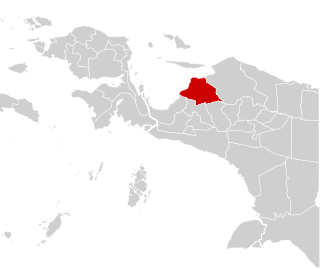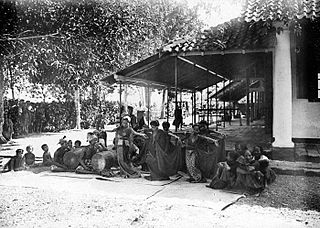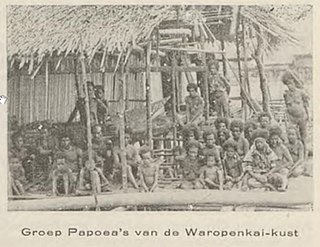Related Research Articles

Papua is a province of Indonesia, comprising the northern coast of Western New Guinea together with island groups in Cenderawasih Bay to the west. It roughly follows the borders of Papuan customary region of Tabi Saireri. It is bordered by the sovereign state of Papua New Guinea to the east, the Pacific Ocean to the north, Cenderawasih Bay to the west, and the provinces of Central Papua and Highland Papua to the south. The province also shares maritime boundaries with Palau in the Pacific. Following the splitting off of twenty regencies to create the three new provinces of Central Papua, Highland Papua, and South Papua on 30 June 2022, the residual province is divided into eight regencies (kabupaten) and one city (kota), the latter being the provincial capital of Jayapura. The province has a large potential in natural resources, such as gold, nickel, petroleum, etc. Papua, along with five other Papuan provinces, has a higher degree of autonomy level compared to other Indonesian provinces.

Yapen is an island of Papua, Indonesia. The Yapen Strait separates Yapen and the Biak Islands to the north. It is in Cenderawasih Bay off the north-western coast of the island of New Guinea. To the west is Mios Num Island across the Mios Num Strait, and to the east Kurudu Island. Off the southeast coast of Yapen are the Amboi Islands and to the southwest are the Kuran Islands. Together these islands form the Yapen Islands Regency within the province of Papua. It is populated with communities of Yobi, Randowaya, Serui, and Ansus. Its highest point is 1,496 metres.

Waropen Regency is one of the regencies (kabupaten) in Papua Province, Indonesia. The Regency covers an area of 10,847.97 km2, and it had a population of 24,639 at the 2010 Census and 33,943 at the 2020 Census. The official estimate as at mid 2021 was 34,414. The capital is the town of Botawa.

Yapen Islands Regency is a regency (kabupaten) in Papua Province of eastern Indonesia. It covers an area of 2,432.49 km2 (939.19 sq mi), and had a population of 82,951 at the 2010 Census and 112,676 at the 2020 Census; the official estimate as at mid 2022 was 116,107. It comprises an archipelago which lies in Cenderawasih Bay off the north coast of Western New Guinea.

The Enggano people are an isolated, but contacted, tribe which inhabits Enggano Island. Enggano Island is a small island located adjacent to the southwest coast of Sumatra in Indonesia. The population of Enggano people is not closely tracked. As such, no population estimates beyond the year 2000 appear to exist. Furthermore, the estimates from 1990 and 2000 are not in agreement. The source for the year 2000 estimates that there were 1,500 Enggano people inhabiting the island, while the 1999 source estimates that there were approximately 1,000 Enggano people inhabiting the island. However, both sources agree that the population is likely to continue decreasing.
The Damal or Damalme are a group of people living in the highlands of the Central Papua province of Indonesia. They primarily live in Beoga Valley along the river of Beogong. The Damal people are closely related to the Delem people, and with the Amungme people living in the southern lowland region. Delem is an ethnic group reportedly descended from the Damal people, Dani people, and Wano people.

The Bonerate people are an ethnic group in South Sulawesi, Indonesia. They inhabit around the Selayar island group such as Bonerate, Madu, Kalaotoa, and Karompa islands.

Singkil people are an ethnic group of people found in Aceh Singkil Regency and Subulussalam, Aceh province, Indonesia.

The Abui are an indigenous ethnic group residing on Alor Island, East Nusa Tenggara, Indonesia. Abui people are spread across the districts of South Alor, East Alor, and Northwest Alor in Alor Regency. Abui people speak the Abui language, which is a Papuan (non-Austronesian) language, as well as Indonesian, and a Malay-based creole known as Alor Malay.

Rotenese people are one of the native inhabitants of Rote Island, while part of them reside in Timor. Apart from that, the Rotenese people also settled in islands surrounding Rote Island, such as Ndao Island, Nuse Island, Pamana Island, Doo Island, Heliana Island, Landu Island, Manuk Island, and other smaller islands. There are some who believed that the Rotenese people originally migrated from Seram Island, Maluku. They were thought to have arrived on the Rote Island during the reign of the Majapahit kingdom in the late 13th-16th century. It was during this time that there were references to the rulers of the Rotenese people. Initially, the Rotenese people founded settlements on the island of Timor, where they engaged in manual slash-and-burn farming and used irrigation system.
Helong people are one of the indigenous inhabitants of Timor Island, in Indonesia. Most of them live in Kupang Regency, namely in West Kupang and Central Kupang; and some also settled in Flores Island and Semau Island. Their livelihoods are mainly farming, hunting, fishing, and making traditional crafts.

Bungku people are an ethnic group who mostly resides in North Bungku, South Bungku, Central Bungku, and Menui Islands districts di Morowali Regency, in Central Sulawesi province of Indonesia. This ethnic group is divided into several sub-groups, namely Lambatu, Epe, Ro'tua, Reta, and Wowoni. Bungku people have their own language, called Bungku language, which is one of their characteristic and serves as a means of communication between themselves. They generally embrace Islam or Christianity.
Serui Malay is a variety of the Papuan Malay language native to parts of the Indonesian province of Papua. It is spoken in the city of Serui and other places on the Yapen Islands, as well as in nearby coastal areas of the New Guinea mainland.
Lembak people, also known as Linggau people, are a local ethnic group that inhabits several areas of Bengkulu Province and South Sumatra Province in Indonesia. Their original settlements are in the border area between the two provinces, in the Barisan mountain range, with densely clustered villages pattern.

Central Papua, officially the Central Papua Province is an Indonesian province located in the central region of Western New Guinea. It was formally established on 11 November 2022 from the former eight western regencies of the province of Papua. It covers an area of 61,072.92 km2 and had an officially estimated population of 1,430,951 in mid 2022. It is bordered by the Indonesian provinces of West Papua to the west, province of Papua to the north, and by Highland Papua and South Papua to the east. The designated administrative capital is located in Nabire Regency.
Yaur is an ethnic group who inhabit the northern coastal area of Nabire Regency precisely in Yaur District. The area inhabited by the Yaur people is included in the Saireri customary territory which includes the northern coast of Nabire, Biak Islands, and Yapen Island.

The Waropen or also called Wonti is an ethnic group that inhabits coastal areas in northern Papua, especially in Waropen Regency and several surrounding areas especially Upper Waropen in Mamberamo Raya Regency. People of the Waropen communicate using Waropen language as their native language, and Indonesian, and Papuan Malay as lingua franca in their area.
The Kaipuri or Miobo are ethnic group who inhabit Kurudu Island in Cenderawasih Bay, Papua. The Kaipuri are one of the two ethnic groups inhabiting the island of Kurudu, besides the Kurudu.
References
- 1 2 Melalatoa, J. (1995). Ensiklopedi Suku Bangsa di Indonesia. Jilid A-K. Jakarta: Department of Education and Culture.
- 1 2 3 4 5 "Orang Kurudu dan Perdagangan di Masa Lalu". www.pustakapapua.com (in Indonesian). Retrieved 18 May 2023.
- ↑ "Kilas Prosesi Peminangan Suku Miobo di Tanah Papua". kadatebintuni.com (in Indonesian). Retrieved 21 May 2023.
- ↑ Handleiding bij de beoefening der Land- En Volkenkunde van Nederlandsch Oost-Indie, 1884, hlm. 431.
- ↑ Runggeary, Alex (2022). Di Tapal Batas: Mambu Ransar. edeposit.perpusnas.go.id (in Indonesian). Makassar: Nas Media Pustaka. ISBN 978-623-351-471-2.
- ↑ "Masyarakat Arfak, Membangun Kehidupan Di Tengah Pandemi, Tak Abai Lingkungan Alami". bbksda-papuabarat.com (in Indonesian). Retrieved 19 May 2023.
- ↑ @paulssukardipapua (27 November 2020). "BENTUK ODEBO, WASRIU DAN BAGIAN-BAGIAN WANTBO (PERAHU TRADISIONAL SUKU KURUDU)" (in Indonesian). Retrieved 19 May 2023– via Instagram.